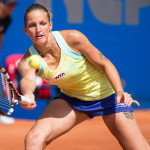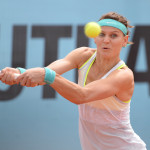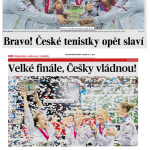All the secrets of Czech female tennis, after winning the ninth Fed Cup, for the fourth time in five years. Its formula? The meticulous training of its athletes, maniacal attention to mental preparation and a strong technical, tactical development program
The Czech Republic women’s national tennis team reaches the top world ranking position. The selection, led by former professional player Petr Pála beat Russia and dominates the international scene by winning the Fed Cup for the fourth time in just five years.
A great triumph that rewards the work done in recent years by a movement that is continuing to grow in terms of public participation and high technical achievements. The sport is, in fact, gradually becoming viral in the Country, thanks to the victories, that have increased the prestige of the Czech Republic around the world.
The development process, however, actually started many years ago and reached its climax when the young Prague girl, Martina Navrátilová, climbed to the top world ranking position, reaching the peak of glory in 1978, with a total of 59 Slam singles and doubles wins, which together with her victories in other tournaments, allowed her to remain in the top ranking of the WTA singles for 332 weeks, for a total of almost seven years. Navrátilová entered the International Tennis Hall of Fame in the year 2000, and in her homeland, she is still considered an icon of this sport, just like Ivan Lendl, not only for the high number of victories, but also for her style, which is elegant and combative. The women’s tennis tradition in the Czech Republic was actually established during the period of Navrátilová and has continued up to the present day, during which the movement has grown considerably and achieved exceptional results. There are now eleven Czech players in the world’s 100 best players, which is an astonishing result, if we consider the total number of citizens that reside in this Country: just over ten million. But that is not the whole story, because, if we reduce the field of investigation to the “Top Ten”, we will find that only the Czech Republic and the United States (with the Williams sisters) can actually pride themselves for having two players at the top of the classification. The Czech players are Petra Kvitová in sixth position and Lucie Šafářová in ninth position, with Karolína Plíšková, poised to enter the “top ten” starting next February. At present, the young player, who was born in Louny in 1992, is in eleventh position, but the gap between her and the German Angelique Kerber does not seem to be so insurmountable, owing to the qualitative leap achieved this season, during which Plíšková obtained international recognition.
 The secret formula? The meticulous training of the athletes, a maniacal attention to mental preparation, combined with a strong technical and tactical development. This is the strategy of David Kotyza, who has been Kvitová’s coach for seven years and a true master of this method – that is directed towards the attainment of the athlete’s maturity. From the very beginning, his method seems quite unique: at the start of his collaboration, Kotyza always asks his players to fill up a questionnaire. A choice that aims to assess the athlete’s psychological condition and that is followed by their self-assessment. “I was really quite surprised by Petra’s approach to tennis and by her intelligence. She wrote down her good and bad qualities, including her strengths and weaknesses and the way to deal with them. She is also very determined and her mindset is a great advantage for this sport. However, from a mental point of view, she was already a champion when she was just a young girl”, her coach explains, and goes on to speak about the beginning of his adventurous work experience with Kvitová. Kotyza then spoke in greater detail about his work approach. “Young generations tend to use the computer and the smart-phone too much. It is important not to misuse these devices so as to allow time for reading, which is an essential exercise for the mental growth of an individual”. Little technology and a lot of reading: old-style planning so as to prepare his athletes to overcome the obstacles of a professional career.
The secret formula? The meticulous training of the athletes, a maniacal attention to mental preparation, combined with a strong technical and tactical development. This is the strategy of David Kotyza, who has been Kvitová’s coach for seven years and a true master of this method – that is directed towards the attainment of the athlete’s maturity. From the very beginning, his method seems quite unique: at the start of his collaboration, Kotyza always asks his players to fill up a questionnaire. A choice that aims to assess the athlete’s psychological condition and that is followed by their self-assessment. “I was really quite surprised by Petra’s approach to tennis and by her intelligence. She wrote down her good and bad qualities, including her strengths and weaknesses and the way to deal with them. She is also very determined and her mindset is a great advantage for this sport. However, from a mental point of view, she was already a champion when she was just a young girl”, her coach explains, and goes on to speak about the beginning of his adventurous work experience with Kvitová. Kotyza then spoke in greater detail about his work approach. “Young generations tend to use the computer and the smart-phone too much. It is important not to misuse these devices so as to allow time for reading, which is an essential exercise for the mental growth of an individual”. Little technology and a lot of reading: old-style planning so as to prepare his athletes to overcome the obstacles of a professional career.
Petra Kvitová is a champion that does not like being under the “pop” media spotlight. She enjoys Italy: “People there are very friendly and cheerful. The food is delicious and there is always plenty of sunshine”, is the somewhat stereotypical confession of the tennis player from Bílovec, a small town in Moravia Silesia. In her spare time, the 25 year old champion enjoys relaxing away from the crowds, spending time with her life partner and playing hockey.
A reserved attitude, just like another protagonist of the Fed Cup, Karolína Plíšková: good food, good music and novels (her favourite writer: Paulo Coelho) and a passion for tattoos. She actually has two tribal ones, that are clearly visible when she is wearing her tennis outfit.
These are the true protagonists of the great triumph that on November 15 led the Czech Republic to conquer the ninth Fed Cup in its history – if we also consider the five won by Czechoslovakia.
In the very modern indoor facility of the O2 Arena, the team, led by Pála, triumphed with a 3:2 score against Russia. A decisive doubles, where the host players, Plíšková and Strýcová, went on to beat the Russians Vesnina and Pavlyuchenkova in 3 sets, after the four singles, in which Kvitová and Plíšková, for the Czech Republic, and Sharapova and Pavlyuchenkova, for Russia, had equitably shared the stakes. The home team has once more delighted its public, that is now all well aware of the girls’ great potential.
A group that does not only consist of the above mentioned top ten champions: at a slightly lower level in the WTA classification, there is Strýcová in 42nd position and Hradecká in 53rd position, both at a mature stage of their career, just as Koukalová in 100th position.
Ranking in 62nd position in the singles is Denisa Allertová: the young player, born in 1993, who will have plenty of time to catch up with the others and try to get into the group of the world’s top players. In the doubles, there are nine athletes in the top 100 list. The Czech Šafářová is in 4th position, after playing the Masters together with Mattek-Sands, while Hradecká and Hlaváčková are respectively in 17th and 20th position.
In view of the exceptional results, we would like to conclude with a curious note for the reader: “How much does a professional tennis player earn”? The WTA also provides a list regarding the proceeds of the players, the “Prize Money” ranking. In 2015, Petra Kvitová managed to earn three million three hundred thousand dollars, ending up in seventh position in the world ranking. Just below her is Šafářová with three million dollars – and above the one-million range, there is also Plíšková with 1,650,000, while Strýcová and Hradecká received about 700 thousand dollars. Large remunerations that bring to light what has now become a certainty: the Czech Republic women’s tennis is no longer just a vague hope, but a solid reality, thanks to its top-ranking women tennis players.
by Alessandro De Felice








